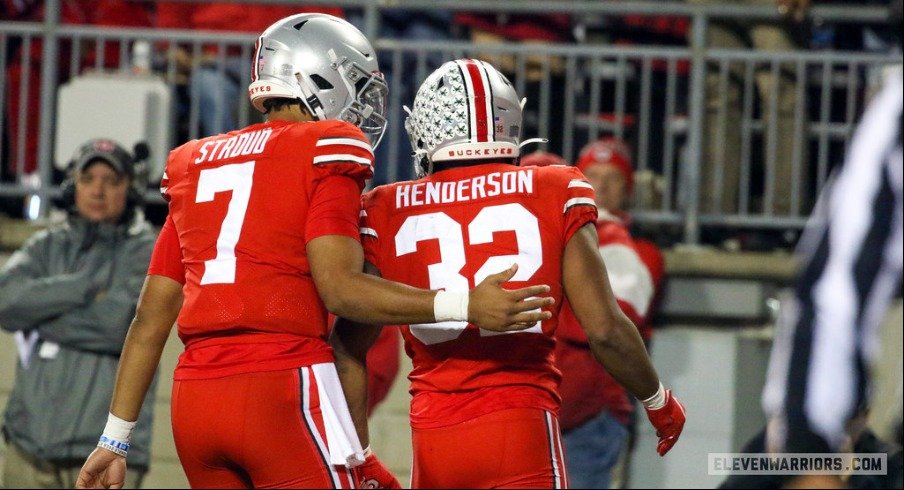Ohio State's offense has been the team's strength on the way to a 7-1 start and No. 5 ranking in the initial College Football Playoff rankings released last night.
The Buckeyes rank No. 1 in the country in both total offense (547.6 ypg) and scoring offense (47.3 ppg) while slotting No. 4 in yards per carry (5.99) and No. 3 in yards per passing attempt (10.5).
Historically, Ryan Day offenses have typically achieved such success featuring a balanced attack that can punish defenses in the run game and stress them over the top in the passing game.
In last Saturday night's win over Penn State, Day's play-calling was as balanced as it can get but 65% of the team's total yardage came via the passing game, marking the third-straight contest and fourth in eight total where the aerial attack accounted for at least 65% of the total yards.
As he met with the assembled media yesterday at the WHAC, Day seemed pleased with the balance in play-calling but the reality is both the play-calling and yardage splits between the run and pass are off-trend with what his offenses showed during his first two seasons at the helm in Columbus.
I think we were 34 and 34 in terms of plays, pass and run (against penn state), and we're always looking for that balance... You just can't throw it 70% of the time. – Ryan Day
After a first half in which Ohio State could get nothing going on the ground, it made sense that Day would retool at the half and make a concerted effort to run the damn ball because while Ohio State played with a close lead instead of trailing like it did for the entirety of the second half against Oregon, it felt like Day wasn't going to let his team become one-dimensional in a tight game again.
That strategy paid off as TreVeyon Henderson ran for 146 yards and a touchdown on 19 second half carries after gaining just six yards on nine attempts before halftime and of course Ohio State earned a tough 33-24 win.
| OPPONENT | RUSH ATT | % TOT PLAYS | RUSH YDS | % TOT YDS | PASS ATT | % TOT PLAYS | PASS YDS | % TOT YDS | TOT OFF YDS |
|---|---|---|---|---|---|---|---|---|---|
| @MINNESOTA | 26 | 54% | 201 | 41% | 22 | 46% | 294 | 59% | 495 |
| OREGON | 31 | 36% | 128 | 21% | 54 | 64% | 484 | 79% | 612 |
| TULSA | 41 | 62% | 326 | 64% | 25 | 38% | 185 | 36% | 511 |
| AKRON | 35 | 57% | 237 | 38% | 26 | 43% | 385 | 62% | 622 |
| @RUTGERS | 37 | 58% | 208 | 38% | 27 | 42% | 333 | 62% | 541 |
| MARYLAND | 33 | 46% | 166 | 28% | 38 | 54% | 432 | 72% | 598 |
| @INDIANA | 32 | 46% | 187 | 35% | 37 | 54% | 352 | 65% | 539 |
| PENN STATE | 34 | 50% | 162 | 35% | 34 | 50% | 305 | 65% | 467 |
| SEASON | 269 | 51% | 1,615 | 37% | 263 | 49% | 2,770 | 63% | 4,385 |
When you look at just this season-to-date, the balanced play-calling jumps off the page. Day has called run plays 51% of the time and pass plays 49% - so almost dead even. Yardage however is pretty slanted, which you expect to some degree, with only 37% of Ohio State's total offense coming on the ground compared to 63% through the air.
So how do both the run/pass attempt and run/pass yardage splits compare to Day's first two seasons in Columbus?
| SEASON | RUSH ATT AS % OF TOT PLAYS | RUSH YDS AS % OF TOT YDS | PASS ATT AS % OF TOT PLAYS | PASS YDS AS % OF TOT YDS |
|---|---|---|---|---|
| 2019 | 62% | 50% | 38% | 50% |
| 2020 | 61% | 50% | 39% | 50% |
| 2021 YTD | 51% | 37% | 49% | 63% |
Interestingly, Day's splits for play-calling and yardage in 2019 and 2020 are nearly identical.
In fact, the rushing yards and passing yards each accounted for exactly half of the team's total offensive output in those two seasons. To achieve that yardage balance, Day ran it 62% of the time in 2019 and 61% of the time last year versus obviously throwing it 38% of the time in 2019 and 39% in 2020.
So far this season however, as noted, Day is running it just 51% of the time - or roughly 12% less than the previous two seasons - while throwing it 49% of the time.
As a result, the yardage is more lopsided with 63% of the team's output coming through the air compared to just 37% on the ground.
Numerous factors go into this obviously - what is the defense giving him, the position group strengths and weaknesses on defense, his own offense's strengths and weaknesses etc. - but it's still interesting to see how his play-calling splits have definitely veered from what we'd seen during his first two seasons as head coach.


